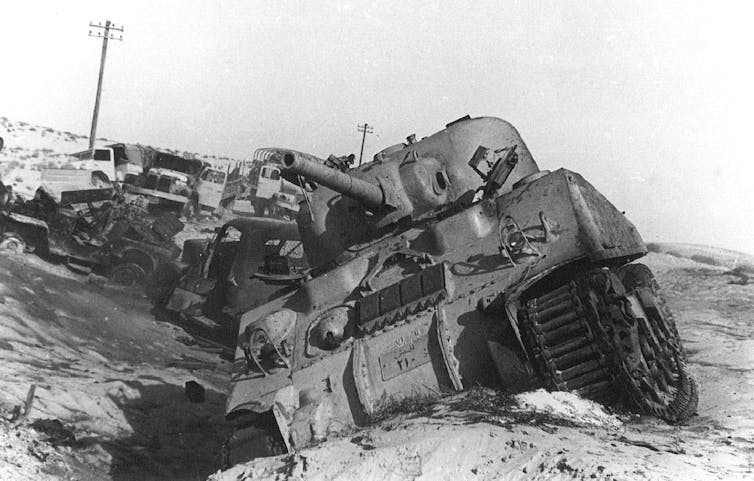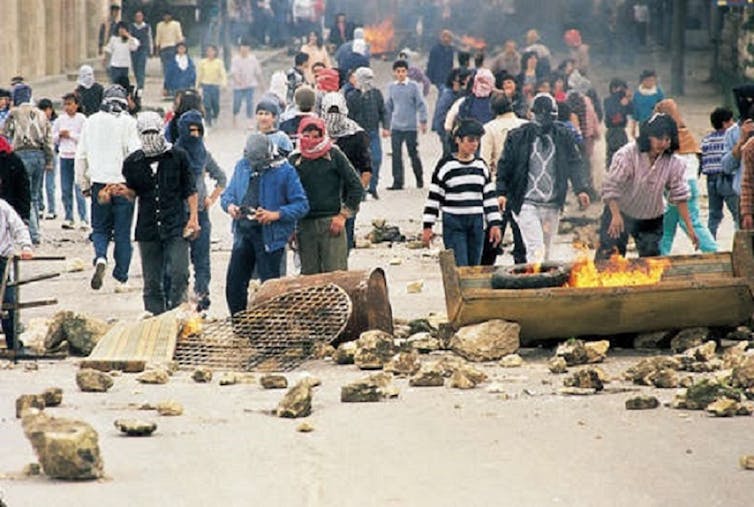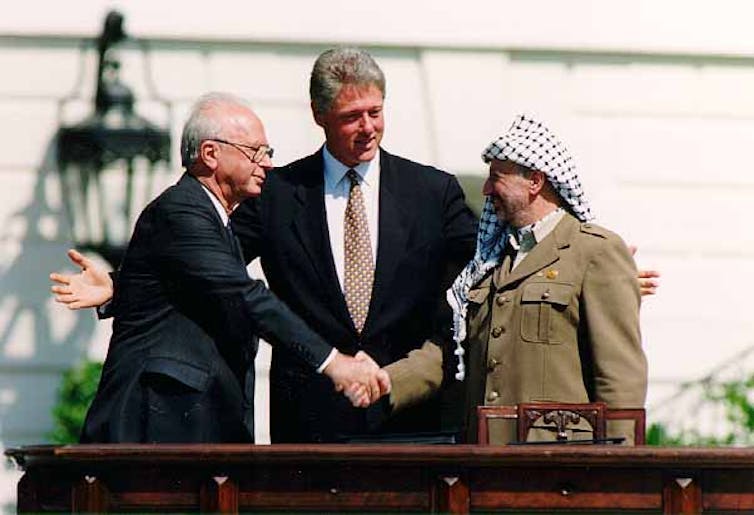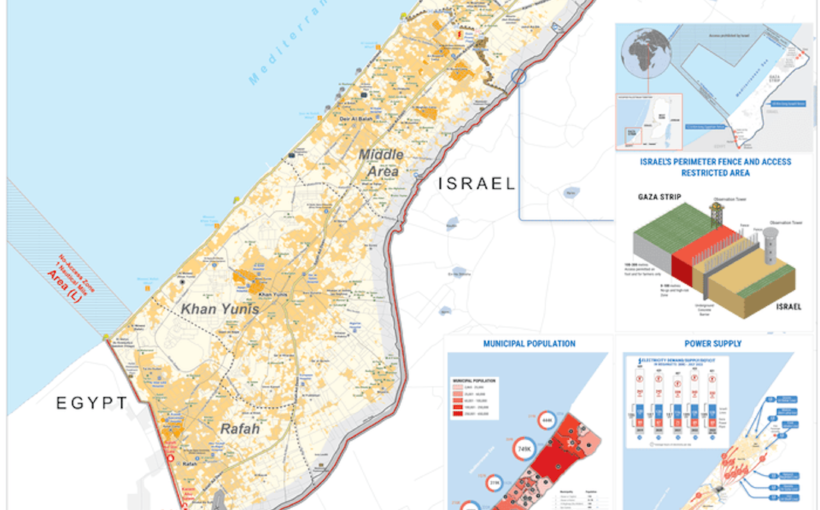Once again, the Gaza Strip is at the epicentre of violence in the Middle East. This tiny 41km-by-13km band of territory on the Mediterranean, sandwiched between the often hostile neighbours of Israel and Egypt, has faced repeated rounds of violence in recent history – but the current war is the deadliest by a long way. More than 5,700 people in Gaza have been reportedly killed by Israeli airstrikes in two weeks of relentless bombardment – at least 2,000 of whom are children.
The aerial assault on Gaza has followed Hamas’s brutal attack on Israel on October 7, in which it crossed the Gaza border in several places, attacked towns and settlements, and killed around 1,400, people, mainly civilians – including an unspecified number of children. More than 200 more people, including women, children and elderly people, were seized and taken into Gaza.
Analysts are now warning of the danger of a full regional war, which could involve Iran and Lebanon as well.

How has such a tiny strip of land – less than half the size of Berlin – become so critical to the politics of an entire region? Over the past 75 years, the Gaza Strip has frequently been the focal point of the conflict between Israel and Palestine. Here are six key moments that led up to the current crisis:
1. 1948: Palestinian dispossession
In 1948, the state of Israel was established. While the United Nations had recommended the previous year that 55% of Palestine be designated for a Jewish state – causing controversy as only a third of the population of Palestine was Jewish at the time – Zionist militias and the Israeli army ultimately took 78%, displacing and expelling large numbers of Palestinians. After Jewish Agency leader David Ben Gurion declared the establishment of Israel on May 14, neighbouring Arab states refused to recognise the new state and instead declared war on it in solidarity with the Palestinians.
In 1949, Israel signed armistices agreeing its borders with neighbouring Arab states. By this time, more than 750,000 Palestinians – around three-quarters of the population – had been turned into refugees. Their dispossession became known in Arabic as the Nakba (catastrophe). Many refugees fled to the two parts of Palestine not absorbed by Israel: the West Bank (which was subsequently annexed by Jordan in 1950) and the Gaza Strip (which came under Egyptian control).
The Nakba transformed the entire Middle East, but it had the biggest demographic impact on the Gaza Strip. A tiny area of land with a population of around 80,000 absorbed more than 200,000 refugees. The Strip’s famously dense population today can be traced directly to the dispossession of 1948.
2. 1956: First Israeli occupation of Gaza
As Gaza was administered by Egypt after 1948, it became a key battleground in the 1956 Suez crisis. After Egyptian president Gamal Abdel Nasser nationalised the Suez Canal Company, Britain, France and Israel launched an attack on Egypt. As part of this, Israel occupied Gaza with evidence of plans for long-term occupation.

In the event, due to US intervention, Israel and its allies were defeated and Washington forced Israel to withdraw its troops early in 1957. But this would not be the last time it occupied the Strip.
3. 1967: Israel begins long-term occupation of Gaza and the West Bank
Over six days of war in June 1967, Israel defeated the Arab coalition of Egypt, Jordan and Syria. It captured the Golan Heights from Syria, the West Bank from Jordan, and the Gaza Strip and the Sinai desert from Egypt. This began its long-term military occupation of the two parts of Palestine not taken in 1948: the West Bank and Gaza Strip.
As Gaza had a reputation for being more “radical” than the West Bank – due to its poverty levels and high proportion of refugees – Israel targeted it for further population dispersal and displacement. During the 1970s, it deployed a combination of carrot and stick measures designed to compel Palestinians to leave Gaza for the West Bank, Egypt, Jordan, and even the Americas.
Successive Israeli governments also moved their own citizens into illegal settlements in both the West Bank and the Gaza Strip. Ariel Sharon’s government would eventually withdraw all 21 settlements in 2005, but Israel retained control over the Strip’s land, sea and air borders.
4. 1987: First intifada begins
In December 1987, an Israeli army truck crashed into a car in Gaza, killing four Palestinians. The incident sparked the beginning of the first intifada (uprising), which would eventually spread across the whole of the Gaza Strip and the West Bank.

Palestinians in both occupied territories boycotted Israeli goods, refused to pay taxes, and withdrew their labour from Israeli employers. There was also widespread stone-throwing at Israeli army vehicles and soldiers.
The intifada shook up longstanding Israeli assumptions that most Palestinians were passive in the face of the occupation, and is credited as a key factor in forcing negotiations in the early 1990s.
5. 1994: Yasser Arafat sets up the Palestinian Authority in Gaza
From 1993-95, the Israeli and Palestinian leaders, Yitzhak Rabin and Yasser Arafat, signed the Oslo Accords, a set of agreements designed to pave the way for a full peace deal. Oslo allowed for limited Palestinian autonomy in parts of the occupied territories.

In 1994, Arafat was instrumental in establishing the Palestinian Authority (PA) in Gaza City, from which Israeli forces partially withdrew. While this was intended as a five-year interim agreement ahead of final negotiations between the PA and Israel, it would last much longer than this in reality.
6. 2007: Hamas takes power in Gaza
As many Palestinians became increasingly disenchanted with the PA’s corrupt and ineffectual leadership, Hamas gained prominence as a rival to Arafat’s Fatah party.
Again, the Gaza Strip was at the centre of this. In 2006, Hamas won Palestinian parliamentary elections, taking 44% of the vote. The result was rejected by the US and much of the western world, which backed the Fatah-led PA.
Following intra-Palestinian fighting in 2007, Hamas took full control of the Strip. In response, Israel imposed a blockade on it, ramping up measures that had first been imposed at the end of the first intifada. Egypt largely supported the blockade, meaning that Gaza’s people were hemmed into a tiny stretch of land, with a dying economy and no access to the outer world.
Since then, Palestinians in Gaza have faced continual violence, with particularly intensive Israeli bombing campaigns in 2008-9, 2012, 2014 and 2021.
But the current war has already exceeded all of them in bloodshed, meaning that Gaza unfortunately looks set to retain its place at the heart of the region’s violence and displacement.
![]()
Anne Irfan receives funding from the British Academy



